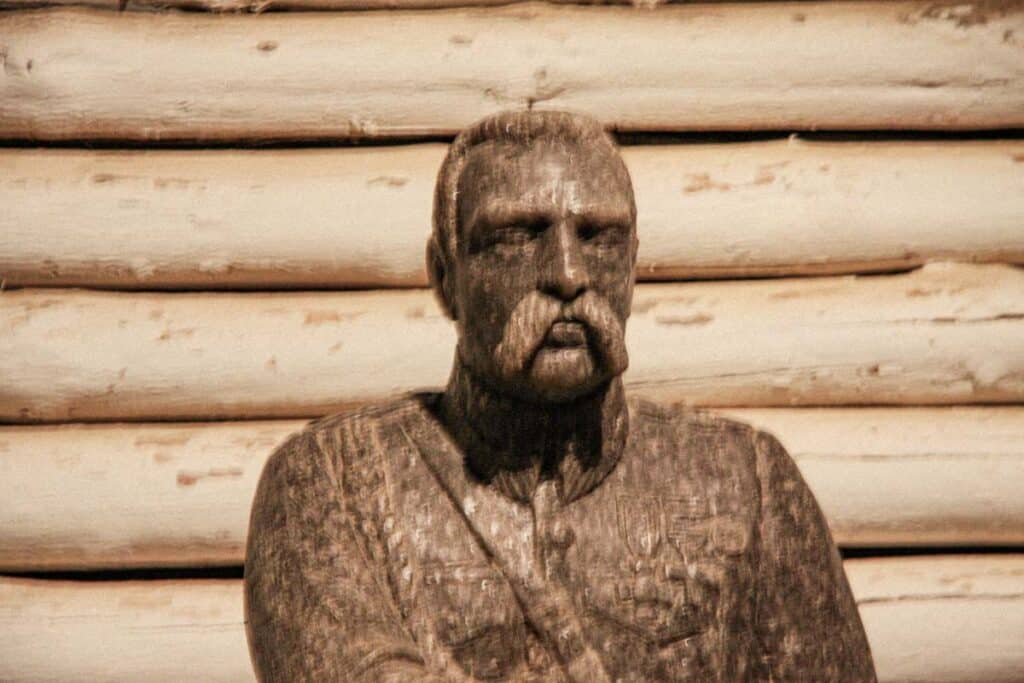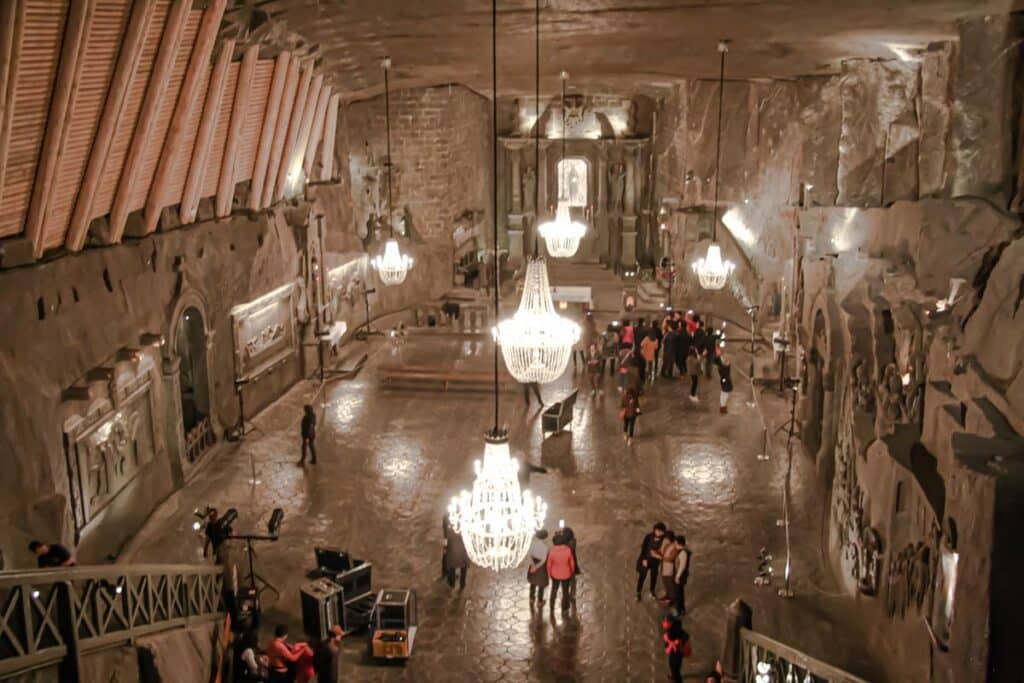We have already introduced Krakow to you in a separate article. But there is also a lot to see in the surrounding area of the city. Today we want to take a trip to the small town of Wieliczka, which is only ten kilometers away.

Cracow Salt Mine – History of Wieliczka Salt Mine
Wieliczka owes its fame to a salt mine, which at times was so important that in the Middle Ages one third of the Polish state budget came solely from the mine’s revenues. The “white gold” used to be a precious commodity. Refrigerators did not yet exist, and high-quality salt was ideal for preserving food for longer.
Initially, salt was mined above ground, probably more than 5,000 years ago. But when the deposits above ground dried up in the Middle Ages, people dug deeper and deeper into the mountain. Over the centuries, a huge labyrinth of tunnels and shafts was created, and it is still not known exactly how big it really is. Experts speak of about 2000 chambers and 300 kilometers of footpaths, of which only about 2% are accessible to the public today.

Working methods underground
One must always keep in mind that in the past the miners had only means at their disposal that seem primitive to us today to do their hard work. They had to use spades and picks to make their way into the depths, always fearing that the ceiling might collapse over their heads.

Later, the work became somewhat easier, as from the 19th century rails were also used, on which first horses and later trolleys carried the salt.

In the course of industrialization, underground processes were then also automated and first steam and then electric machines were used, for example jackhammers and elevators.
The Wieliczka Salz Mine today
In the mid-1990s, after about 700 years of uninterrupted activity, work in the salt mine ceased and Wieliczka was turned into a museum. However, this does not mean that hundreds of miners are not still working here. They are in fact responsible for ensuring that the many shafts are secured and that visitors can be received.
Your visit to the Wieliczka Salt Mine
Today you can explore the salt mine on two routes and make exciting discoveries. The Wieliczka Salt Mine is not just an ordinary mine where salt was simply mined. Many works of art were created here, made by the miners and joined together to form a kind of underground city.
Cathedrals for eternity
These works of art are above all an expression of the deep religiosity of the Polish miners. Countless chapels and statues can be found here. Many are dedicated to St. Kinga, the patron saint of miners. The works of art have survived the time also because it is not salt, as you may imagine now. The salt appears here in stone form, so to speak. It is rock salt, which was formed as a precipitate from concentrated sea water.

The most beautiful place in Wieliczka is the Chapel of St. Kinga. It is rather a huge church. It was created in the 18th century and the relics of the saint are also located here. From the 19th century church services were held here regularly. At that time, the priest could not go inside the mine by electric elevator as easily as we do, but had to take the often dangerous way into the dark, just like the miners.

On the walls of the chapel are beautiful reliefs, including one that shows a copy of the famous “Last Supper” by Leonardo da Vinci. Just like the other works of art and statues of saints in the chapel, the relief is made entirely of salt.

Especially beautiful are also the huge chandeliers made of salt crystals. Church services are still held here occasionally, you can even get married here!

For me, however, the shafts themselves are the real attraction. Sure, the holy figures, reliefs and chandeliers are quite impressive, but walking through the dark corridors and never knowing what awaits you at the next corner is definitely one of the most exciting experiences underground. Along the way, you’ll also come across steep staircases, small underground lakes and many other exciting places.
The routes in the Wieliczka Salt Mine
The tourist route leads past the “classic” sights of Wieliczka. You will have to walk for about two hours and climb about 800 steps. The miner’s route is only about half as long as the tourist route in terms of pure walking distance, at just under two kilometers, but you will be on the move for three hours. That’s because it’s much more challenging and you’ll be actively involved, for example measuring the methane content in the air or searching for salt! No matter which route you choose, a visit to Wieliczka is definitely an experience!

Practical tips Wieliczka
- How to get there: A suburban train connects Kraków’s main train station (Dworzec Główny) with Wieliczka Rynek Kopalnia station. From there, it’s only a few minutes’ walk to the giant winding tower where the tours begin. Alternatively, take bus 304 from the West Main Station (Dworzec Główny Zachód) and get off at the Wieliczka Kopalnia Soli stop.
- Museum: On the website of the museum you can also inform yourself in advance in English about the tours offered. The prices change relatively often, so it is best to check there beforehand. Groups should book in advance. If you are traveling alone or in pairs, this is not necessary, but especially in summer it can get very crowded and you may have to wait a long time without a reservation.
- Accommodation: Only a few meters from the Daniłowicz Shaft the Grand Sal Hotel* is located. Here you can not only stay overnight, but also book wellness treatments with salt. The hotel also uses the Droudowice chamber at a depth of 110 meters as a conference hall.
- Food: Deep in the mountain, at a depth of 125 meters, there is a small canteen where you can fortify yourself on the way. The food is good and the unique environment makes Polish home cooking taste even better!
- Clothing: It’s below 20° Celsius year-round down here, so remember to wear a sweater or light jacket in the summer and don’t wear too many clothes during winter.
- What do You think about Wieliczka? Have you already been here? Let us know and leave a comment!


Good article.
Just two things to correct. The commercial salt production was finished in 1996, but it is not beginning of tourism in Wieliczka Salt Mine. That have started around XV century and the first organized tourist route dates back to 70-ties of XVIII century. Already in XIX century it was really popular tourist attraction.
Even today there is still a tiny production of salt. There are two ways of getting salt, both however are connected with maintenance of mine. The first is evaporating water that floods the mine (the pure white salt) and second during some same restoration work miners get grey salt which in this case is waste product. Both kinds of salt can be purchased in souvenir shops. Additionally white salt is also processed to cosmetic salt with different flavors. So most of salt souvenirs (except pink salt) are produced in the mine!
Dziękuję ci serdecznie za uwagi! Thank you so much for your comment!